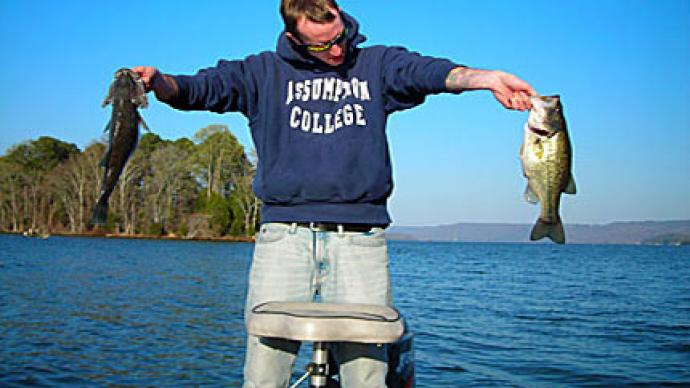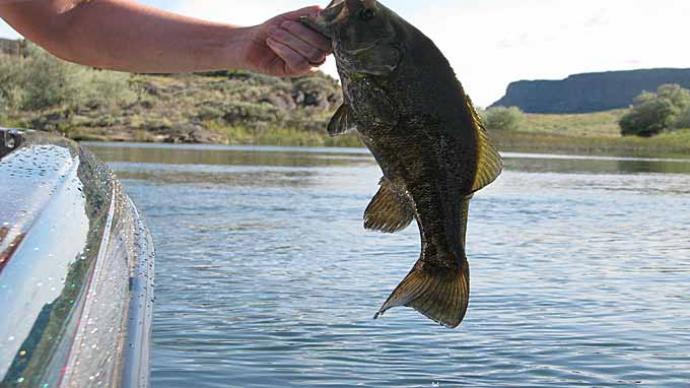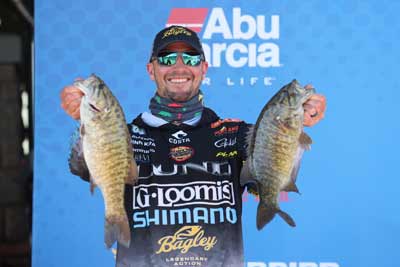
Bass anglers are always looking for the next best thing, a technique or rig that puts more and bigger bass in their boat. So, it’s no surprise they met the drop-shot rig with open arms. Moving the weight below the lure opened the door to staggering catches of offshore smallmouth that have won tournaments and injected fun into weekend fishing excursions.
A drop shot catches its fair share of largemouth and spotted bass. But it’s challenging to find a rig that has had a bigger impact on smallmouth fishing. It pushed aside spinnerbaits, tube jigs, and even topwaters as the go-to technique. While smallmouth still bite those lures, they can’t seem to match the drop shot’s production. Regardless of location, time of year, or weather, there isn’t a situation when a smallmouth won’t bite a drop shot. “It’s comparable to a Ned rig, where it’s a great option for both shallow and deep,” said Bassmaster Elite Series angler Jeff Gustafson. “It’s just a finesse technique and a good way to present a finesse bait, which usually a smallmouth can’t pass up.”
While most of the drop shot’s dominance can be credited to the rig itself, it has had some help along the way. Improved electronics, for example, allow anglers to find, follow and catch open-water smallmouth with GPS, mapping, and scanning. And trolling motors quipped with spot-lock technology effortlessly hold boats precisely in place in the roughest water, improving presentations. The drop-shot has evolved, too. Being the creative bunch they are, anglers have discovered tweaks that have made it even better.
Gustafson is intimately familiar with smallmouth, a two-time Bassmaster Classic qualifier, and recent Elite Series winner. The Keewatin, Ontario, Canada, resident chases them from the tournament trail to outside his front door on Lake of the Woods. An early adopter of the technique, he has maximized the effectiveness of each component of his drop-shot setup — from rod to weight. Follow his lead, and your rig will catch more and bigger smallmouth, too.
Rod
When Gustafson reaches into his Lund’s locker, he usually grabs a rod a bit longer than average — 7 feet or more. But when he fishes a drop shot, he wants a short one. His choice is G. Loomis’ lightweight and ultra-sensitive NRX+ drop-shot rod, which measures 6 feet and 10 inches.
A shorter rod keeps his drop shot, which Gustafson fishes nearly vertically beside his boat, within the cone of his bow-mounted graph’s transducer. He can keep an eye on it and any smallmouth swimming over to eat it.
Gustafson keeps the movements of his rod tip short, too. “A big mistake that I see people making [while drop-shotting] is they want to shake their rod violently all the time,” he said. Instead, he’s found that the best approach is to allow your rig to sink to the bottom and slowly pull it, moving the line more than the weight. “If you’re in current, it will impart action, and the weight bouncing along the bottom will impart some action in the bait as well,” he said.
Reel
While nearly any spinning reel will work with a drop shot, Gustafson has uncovered a few characteristics that are well suited to the technique. Keep them in mind when you’re shopping for a new spinning reel.
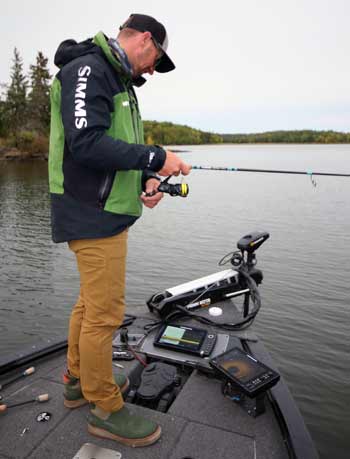
Gustafson steps up to a 2500 or 3000-size spinning reel. Their slightly larger diameter spools cut down on line twists and subsequent wind knots. That’s a critical frustration reducer considering the lightweight lines employed with today’s drop-shot rigs.
A smooth drag is significant, too. Gustafson said it should effortlessly release at the proper instant, keeping your line from breaking while battling a giant smallmouth. Better ones are found on top of spools, not on the back of the reel’s body. There they can incorporate larger discs, which slip easier than smaller ones.
Gustafson said finding all of these characteristics in one reel may require stepping up a model or two. He said they are included on reels such as Shimano’s Vanford. “If you want to get the best available, you could check out the Shimano Exsence,” he said. “I have one, and it’s the finest spinning reel I’ve ever used. It will likely last me the rest of my career.”
Hook
Gustafson selects his drop-shot hook based on what and where he’s fishing. When he’s targeting smallmouth in open water with smaller drop-shot lures, he ties on Gamakatsu’s G-Finesse drop-shot hook. “It’s a hook designed for nose-hooking baits,” he said. The real selling point of this thin-wire hook is its point, which is slightly angled out. That expands its gap, providing plenty of room for a lure and bass, improving your hook-to-land ratio.
Some smallmouth prefer big lures, even on a drop shot. Gustafson steps up to a 5-inch Z-Man Jerk ShadZ on Lake St. Clair, the Great Lakes hotspot that Michigan and Ontario share. Its extra length and deeper body require a larger straight-shank hook such as Gamakatsu’s G-Finesse worm hook. “I’ll thread the bait onto the hook and let the point protrude out the back like it’s rigged on a jig,” he said.
A Palomar is the most popular knot for attaching a hook to a drop-shot rig. Easy to tie and strong, start by inserting your doubled-over line through the hook from the point side. That ensures the point will be on top when the knot is cinched tight. Gustafson also ensures that his knot perfectly aligns with the hook’s shank, making his lure look and act natural in the water.
Weight
From basic bell-shaped to cylindrical, the weights used on drop shots have also changed. Gustafson prefers ones with a tear-drop shape. “They just give the best bottom feel and look the best, in my opinion,” he said.
Gustafson is particular about the material they’re made from, too. “I’m a big fan of tungsten [weights] …,” he said. Denser than lead, tungsten sinkers of equal weight are smaller in size. They are harder, too, transmitting better information about bottom composition up the line and into our hands. Sand bottoms, for example, create a uniform sensation, while rocky bottoms create taps.
Pay attention to your drop-shot weight’s line tie. Many feature a narrow attachment that wedges on the line. “If you use [those], you just lose [your weight] every time you hook a big smallmouth, and it jumps,” Gustafson said. “I’ve been using Flat Out Tungsten weights over the past couple of years, and they are nice because you can tie them on.” They feature an open loop attached to a swivel, which cuts down on line twist.
With its weight acting like an anchor, it’s tough to overpower a drop-shot rig with too heavy of a sinker. But that doesn’t mean you should tie on a 1-ounce one and be done with it. Instead, Gustafson picks one slightly heavier than the jig he would use in the same depth, current, and cover. “I want it on the bottom doing its thing,” he said.
Lures
Gustafson said, catching more smallmouth on a drop shot still starts with finding them. But once you’ve zeroed in on a school, you need the correct lure. “I think a drop shot is a top finesse technique still today, but what we’re seeing is a trend toward more finesse … and using more baits designed for drop shotting,” he said.
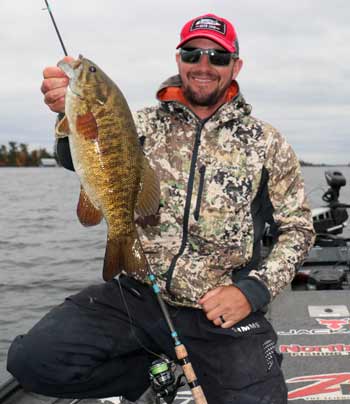
The drop-shot bait that has gained most of Gustafson’s confidence is Z-Man’s Trick ShotZ, specifically designed for the technique. It’s available in two sizes — 3.5 and 4.2 inches — and sports ribbed sides and a flat spade-shaped tail. Those add action to a lure that’s moved in place; drop-shot lures don’t have the luxury of forward movement to create action. “It has a goby profile, but it’s small enough to be a finesse bait as well simply,” he said.
Gustafson’s other go-to lure for his drop shot is Z-Man’s Finesse Shadz. It measures 4 inches, and its thicker head tapers into a slim tail, which quivers with the slightest movement. “Every time we go to the St. Lawrence River, I have guys coming around looking for these baits,” he said. “So, you know they’re catching fish.”
These lures share a trait — the material used to pour them. “I’m using a lot of the Z-Man ElaZtech baits that inherently ‘float,’ and they create a unique presentation that allows you to hang the bait in their face a little more,” Gustafson said.
Line
Line ties together Gustafson’s drop-shot setup. And he’s found only one choice — braided line. It handles any situation that he can envision fishing with a spinning reel. “Braid just resists twisting,” he said. “It handles better. It’s more sensitive. You get a better hookset. There are just way too many advantages.”
Gustafson’s choice for drop-shotting is 8-pound test Power Pro. He adds a fluorocarbon leader of equal or lesser pound test, depending on conditions, with an FG knot. It usually measures 8- to 10 feet long. That provides enough material for a retie or two and enough distance between his braid and lure to fool wary smallmouth swimming in crystal clear water. It also keeps his knot from reaching his reel. Passing on and off the spool reduces casting distance and eventually weakens it.
BassResource may receive a portion of revenues if you make a purchase using a link above.


